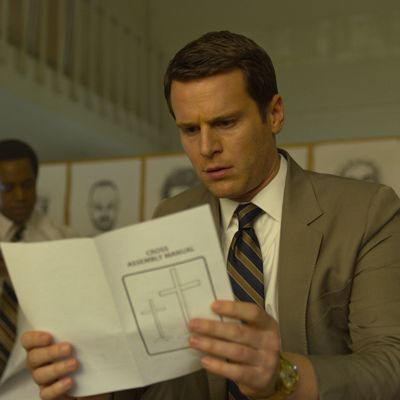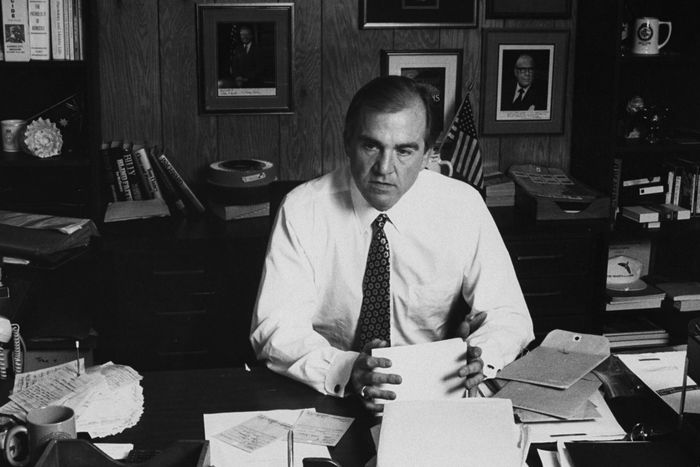
Criminal profiler John Douglas isn’t exactly a household name, but his work has influenced a vast amount of pop culture from Silence of the Lambs to Netflix’s Mindhunter. As the real-life inspiration behind Mindhunter’s main character, Holden Ford (played by Jonathan Groff), Douglas was a founder of the FBI’s Behavioral Science Unit and one of the first agents to interview serial killers in an attempt to better understand future predators.
Though retired from the FBI since 1996, Douglas continues to work on cases and has written several books about criminal profiling — his latest, co-written by Mark Olshaker, is The Killer Across the Table — and he lends a knowledgeable hand to TV shows and movies that aren’t, as he puts it, solely about “blood and gore.” (He’s even developing a podcast based on his original Mindhunter book.) Now, the Netflix drama inspired by one of those books has revisited one of the more controversial chapters of his career: the Atlanta child murders. Though a man named Wayne Williams was convicted in 1982 for two murders tied to the case, Douglas doubts that Williams is responsible for many of the other 26 killings — despite matching a profile that Douglas himself made when he began investigating the case in the ’80s — and Atlanta police officially reopened the case last March.
Vulture sat down with Douglas to chat about the fact and fiction of Mindhunter, the Atlanta child killings, the most notable interviews of his career, and why he wants Netflix to keep renewing the show until Ford finally catches the BTK killer.
This season, I felt like I saw more of you in Bill Tench than Holden Ford. What did you think?
You’re right! You know when Holden is getting chewed out at the retirement party? If it’s just me, this person that’s superior to me in rank, and no one’s around, I’m not going to take it. You’re going to call me a twerp? No, you’re not going to get away with that. I never challenged a person I was interviewing, either. I would never call Manson “you little shit” or whatever the hell term was used. No, I stroked his ego. I let him feel like he was in control of the interview.
What was it like to speak to Charles Manson?
We actually went back a couple of times to interview Manson. He did take the sunglasses. He wanted to show everyone that he ripped us off because everyone would know that he was talking to the FBI. [Mimicking back and forth with Manson] “I want those glasses.” “These are Ray-Ban glasses. These are expensive!” “I’ve got to take them back, man. I’ve got to show everybody I ripped you off.” So he took the glasses and he never gave them back! Unlike in the show.
A lot of characters on the show are based on real people, but they’re pretty fictionalized. What did you think about the story line with Tench’s son? Should we be worried about him?
Well, it did not happen to the real guy Tench was representing, [Robert] Ressler, but that case does exist. It was up in San Francisco. A woman in a park with a 20-month-old toddler. Two brothers, 10 years old and 7 years old, snatch the child. They kill the child in the basement with a brick and then they attach a cross to the child, believing that the child’s going to be resurrected. So that did happen.
The Atlanta child-murder case was one of the Behavior Science Unit’s first huge investigations, and it plays a big role in Mindhunter. What can you tell me about the real case?
Throughout the whole trial, all the months leading up to the apprehension, I would come and go because I had other work. By 1981, not only did I have the Atlanta child killings, but I had the Tylenol murders. We had the Unabomber case up in Chicago. Then we had other cases, Buffalo’s .22-caliber killer.
I did the written analysis of the case and people didn’t like it. The FBI had me sit down and do an interview with People magazine. In the interview, I say the suspect is going to be black. I’m back on the case down there, I walk into a task force and pretty much the entire force was African-American. Even the agent in charge of the FBI office, John Glover, was the first African-American agent in charge of an FBI office. He wasn’t introduced at all in the show. And so, I wasn’t warmly welcomed.
They were afraid that I was going to create a race war. I remember walking down to one of the crime scenes and a detective says, “You’re Douglas?” And I say, “Yeah.” And he said, “I saw your profile. It’s a bunch of shit, man.” I said, “Fuck you, man. I didn’t ask to be here. I just want to go back to Quantico. I got a lot of cases waiting for me back there.”
To me, the turning point in the case came when a guy called up the police saying that he was the killer. He’s using the N-word, giving directions on where we can find another body. I hear the tape and I said, “That’s not the killer. But we got to catch him because if we don’t, he’s going to be bothering the hell out of this investigation.” What do we do? We’re gonna show how stupid we really are. Lo and behold, the guy calls in, “You dumb-asses, I told you to search this side of the street. You searched the other!” We traced the call and caught him. What’s the significance? Well, that ended up in the newspapers in Atlanta. And who read it? The killer. Within a day or so, we end up with a body on Sigman Road. Now, for certain, we know they follow the press.
The crosses they used for the memorial were a real suggestion I had, too. It was true that the Bureau was arguing among themselves who’s going to make the crosses. They went back and forth. It was never done. That’s why, after a while, I would do things without asking for permission. Just asking for forgiveness if I screwed up.
The scene where they build the crosses never happened?
No, never got to them! I have several things that I wanted to do. The big Sammy Davis Jr. and Frank Sinatra concert, I knew the unknown subject was going to be in that audience. So I said, “Let’s look for somebody who has some type of security background who has a vehicle. We can screen them right away. We can get rid of all the females. We’ll get rid of people who don’t have cars. We can eliminate through race.” Again, it was a great idea. It wasn’t used. We know later on that Williams was at that concert.
Oh my God.
Yeah, they wonder why I drink. [Laughs.]
Do you think the right man was caught? The Atlanta police reopened the case earlier this year.
I never thought that Wayne Williams did all of those cases. There are other cases that should not be on the list. Two of the girls, Angela Lanier and Latonya Wilson, and some other ones that did not fit. Roy Hazelwood [another FBI profiler] and I had about ten of them that we thought were behaviorally linked. Now they are looking at it again. It’s not that [Williams] didn’t do any [of the murders]. But it’s the question, did he do all 28 of them?
If investigators contacted you, would you help out on the reopened case?
I definitely would go back.
Mindhunter is also slowly unraveling the BTK case. How frustrating was the actual investigation? You started getting information on him in the ’80s, right? He wasn’t caught until 2005.
Dennis Rader, he wasn’t any genius. He was just very lucky. In 1984, we said he was a police-buff type, attending college and probably in criminal justice. He was. He was a pseudo–enforcement officer. You see that and you think, Gee, had they just maybe gone over there … It was really the stupidity of Rader that got him caught, unfortunately. It wasn’t because of super-duper police work. He wasn’t smart like Ed Kemper. He was more on the lines of David Berkowitz, the same kind of average IQ.
I hope the show sticks with the BTK case because I want to see Ford and Tench catch him.
They’ll have to speed up on it because he gets caught after I retired. But they got some other great cases. From Ted Bundy, John Gacy, Robert Hansen, the Alaskan serial killer who hunted women down like wild animals after setting them loose up in the mountains. The Green River murder case that nearly did me in. Also, I interviewed assassins. Besides Squeaky Fromme and Arthur Bremer, we did Sirhan Sirhan, Sarah Jane Moore who shot at Ford along with Squeaky Fromme. So you can even get into some of the assassination types. It’s just how long they want to take it. It can go a long, long time, really.
You’ve talked to so many infamous criminals over the years. Was there ever a killer you were excited — for lack of a better word — to interview?
I don’t know if “excited” is the right word, but I was fascinated by the worst ones. Gary Heidnik in Philadelphia, who inspired Buffalo Bill in Silence of the Lambs — I did an analysis because I assisted the prosecution. We knew he was going to claim that he was insane. He did do some insane acts — like imprison and torture half a dozen women by keeping them in a pit with water in it, by putting an electric current on the shackles around their wrists — but he was not insane. When you look at the crime scene, the victims were kept in the cellar, with various concrete blocks around the window so no one could hear any screaming. His crimes were certainly insane, but he knew right from wrong.
Another one was Lawrence Bittaker and Roy Norris out in California. My God, these guys raped and killed a half-dozen women, young teenagers, playing audiotape as they tortured them. I have the tapes of these victims who are begging for their lives. I made Scott Glenn of Silence of the Lambs, who portrayed me, listen to them when he came to my office. He got all emotional and said, “John, I was against the death penalty, but I didn’t know there are people like that.”
Let’s end on a lighter question. In Mindhunter this season, Holden says that he likes New Wave music. Are you actually a New Wave fan?
No, I like soul music. Right now in my car, Sirius, I got the soul channel. But not the spiritual soul. I used to watch Soul Train after school. I’d be down in the basement with a black-and-white TV, learning the latest moves.
This interview has been edited and condensed for clarity.





